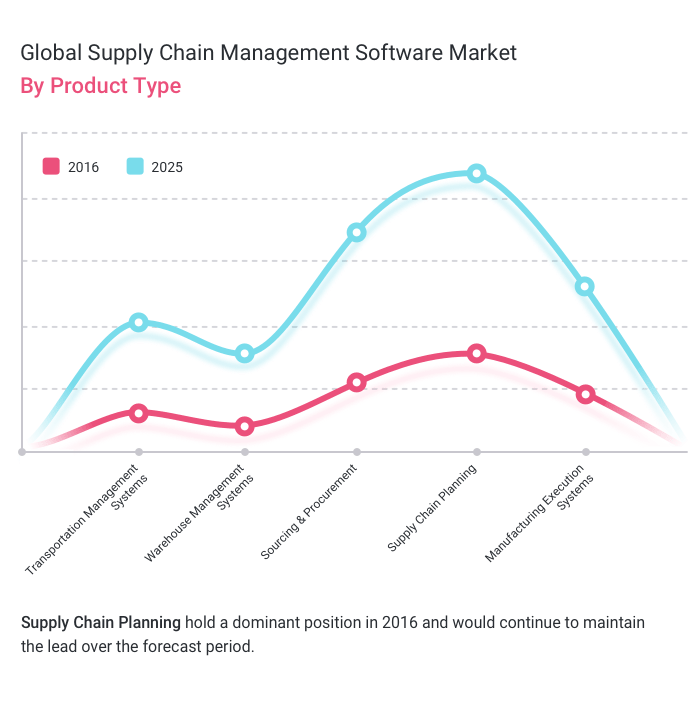Supply chain management (SCM) software is utilized in supply chain transactions. It aids in overseeing supplier relationships and business processes of supply chain members: manufacturers, logistics services suppliers, retailers. Supply chain management program sector is anticipated to reach $24.532 billion by 2025, growing at a compound annual growth rate of 9.7% from 2018 to 2025 according to Allied Market Research. SCM software market predictions, technologies costs, and trends you’ll find reading further.
According to Allied Market Research Western Europe and North America keep on being the prime supply chain management soft consumers. It’s interesting to have a look at the slice of a deployment model. The on-premise SCM soft segment kept the leading position at the market in 2016 and is relied upon to keep staying predominant over the next nine years. In the product slice, Supply Chain Planning is considered to grow the most to 2025.

New Technology in Supply Chain Management: What are the Leaders Discussing as Supply Chain Management Technology Trends?
How can technology improve supply chain management? At Gartner Supply Chain Executive Conferences Innovators the Leaders discussed Top 8 Supply Chain Technology Trends in 2019, which are:
- Artificial Intelligence (AI)
- Advanced Analytics
- IoT
- Robotic Process Automation (RPA)
- Autonomous Things
- Digital Supply Chain Twin
- VR and AR
- Blockchain.
How much do Cutting-Edge technologies cost, can a mid-size and small business afford them, and for what purposes?
| Technology | Approximate cost | Technology in supply chain management |
| Artificial Intelligence (AI) | From $100k for a simple tool. |
|
| Advanced Analytics
Makes sense with the presence of pre-collected information, on the basis of which it is possible to do either research or solve extraordinary tasks that cannot be executed with the help of relational databases. |
Data scientist average salary is $113,436 per year, according to Glassdoor. |
|
| IoT
Interconnected sensors and trackers |
Starting from $18k. |
|
| Robotic Process Automation (RPA) | Starting from $5K for a simple feature/bot. |
|
| Autonomous Things | By different sources starting from $3K for an autonomous drone to $300K for a driving vehicle (the technology is still under the tests, much time will pass before the mass production) |
|
| Digital Supply Chain Twin
A digital model of a physical world object |
Starting from $20k. |
|
| VR and AR | From approximately $50K for an app. |
|
| Blockchain | From $5K. |
|
As one can see from the table above, some cutting-edge technologies are still far from mass implementation for the majority of supply chain participants and are available to a very limited circle of key market players. Fortunately, there are quite accessible technologies to medium-sized businesses and even small businesses. And they will be quickly and massively implemented due to their relatively affordable price. According to Everett Rogers, before Late Majority is ready to accept the use of technology in supply chain management, 50% of all technology adopters are already using it and getting benefits of it.
From this point of view, technology becomes not a market advantage for the most tech-savvy companies, but a standard in the sphere on the whole. Unfortunately, off-the-shelf soft developers are not able to take into account all the specifics of a particular business.
For example, when transporting petroleum, it is necessary to take into account not only standard parameters but also very specific ones. For instance, pressure, temperature, humidity, and level sensors control the level of oil in cargo tanks, its viscosity and other parameters. They are necessary as the state of oil plays a significant role in the transportation process and transfer. Custom logistic software development is considered to be an excellent solution in this case. With the help of IoF, the data is gathered and stored into one cloud-based system. RPAs can extract and reformat this data, organizing it into reports or dashboards. The same data may be used for advanced analytics if it’s not about one tanker, but about a whole cargo fleet of a commercial enterprise.
In custom development, XB Software can use different combinations of cutting-edge technologies within the given budget to find the necessary minimum for working solution implementation. This approach will allow adding new functionality to the system as your business grows. Our team has extensive experience working with previously had experience with the majority of the above mentioned technologies, developing custom software for supply chain management.
Get a free consultation or learn more about our possibilities to empower your business with the upcoming technologies.